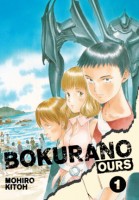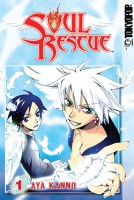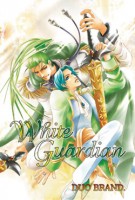My News and Reviews
Two reviews were posted at Experiments in Manga last week, though neither of them were actually for manga. First up was Yasutaka Tsutsui’s The Girl Who Leapt Through Time, which collects two of his stories: The Girl Who Leapt Through Time and The Stuff That Nightmares Are Made Of. The Girl Who Leapt Through Time is one of Tsutsui’s most well-known and beloved novels and was the inspiration for Mamoru Hosoda’s 2006 anime by the same name, which happens to be one of my favorite animated films. I also reviewed Dan Mazur and Alexander Danner’s Comics: A Global History, 1968 to the Present. It’s an extremely informative volume and highly recommended for people who are interested in the history of comics, including manga. I wasn’t online much last week, but I did notice that Revealing and Concealing Identities: Cross-Dressing in Anime and Manga, Part 6 was posted at The Lobster Dance, focusing on Fumi Yoshinaga’s marvelous series Ōoku: The Inner Chambers. If there were any big announcements or other noteworthy news items that I missed, please do let me know!
Quick Takes
 Andre the Giant: Life and Legend by Box Brown. Growing up, I knew of Andre the Giant from his role as Fezzik in the film The Princess Bride, only later learning about his professional wrestling career. Andre Roussimoff was a literal giant of a man—at one point over seven feet tall and over six hundred pounds—who also suffered from acromegaly, though he wasn’t diagnosed with the condition until he reached his twenties. Brown’s thoroughly researched biographical comic captures Andre’s life and legacy, revealing just how human the legend really was. Like anyone else, he had his strengths and his flaws. Because of his size the life he led was an unusual one and he was treated differently, and not always kindly, by other people. Surprisingly, Andre the Giant: Life and Legend is actually one of the very few works devoted to Andre. It’s a collection of stories and anecdotes about the man beginning with his childhood in France and then following him through his globe-spanning career as a professional wrestler as well as his time on the set of The Princess Bride. The comic is very well done and includes a bibliography in addition to notes on the sources used.
Andre the Giant: Life and Legend by Box Brown. Growing up, I knew of Andre the Giant from his role as Fezzik in the film The Princess Bride, only later learning about his professional wrestling career. Andre Roussimoff was a literal giant of a man—at one point over seven feet tall and over six hundred pounds—who also suffered from acromegaly, though he wasn’t diagnosed with the condition until he reached his twenties. Brown’s thoroughly researched biographical comic captures Andre’s life and legacy, revealing just how human the legend really was. Like anyone else, he had his strengths and his flaws. Because of his size the life he led was an unusual one and he was treated differently, and not always kindly, by other people. Surprisingly, Andre the Giant: Life and Legend is actually one of the very few works devoted to Andre. It’s a collection of stories and anecdotes about the man beginning with his childhood in France and then following him through his globe-spanning career as a professional wrestler as well as his time on the set of The Princess Bride. The comic is very well done and includes a bibliography in addition to notes on the sources used.
 Bokurano: Ours, Volume 1 by Mohiro Kito. One summer, fourteen seventh graders and a fourth grader participating in a nature school program wander into a seaside cave where they discover a strange man holed away who invites them to play a game. They will be placed in charge of piloting a giant robot in order to fight massive alien invaders. Except that the game they’ve agreed to play turns out to be much more real than any of them counted on. This early in the series it’s a little difficult to get a good feel for all of the characters since there are so many of them, but it seems that as they each have their own opportunity to pilot the robot more will be revealed about them as individuals. It also looks like the series will have a fairly high death count, too, even when it comes to main, named characters. Bokurano: Ours has a dark ambiance as well strong psychological elements. Though there are grand battles, the real drama of the series revolves around how the children respond to being granted such enormous power. Some delight in the chance to wreak havoc while others are more hesitant, understandably concerned about the strange situation they’ve gotten themselves into.
Bokurano: Ours, Volume 1 by Mohiro Kito. One summer, fourteen seventh graders and a fourth grader participating in a nature school program wander into a seaside cave where they discover a strange man holed away who invites them to play a game. They will be placed in charge of piloting a giant robot in order to fight massive alien invaders. Except that the game they’ve agreed to play turns out to be much more real than any of them counted on. This early in the series it’s a little difficult to get a good feel for all of the characters since there are so many of them, but it seems that as they each have their own opportunity to pilot the robot more will be revealed about them as individuals. It also looks like the series will have a fairly high death count, too, even when it comes to main, named characters. Bokurano: Ours has a dark ambiance as well strong psychological elements. Though there are grand battles, the real drama of the series revolves around how the children respond to being granted such enormous power. Some delight in the chance to wreak havoc while others are more hesitant, understandably concerned about the strange situation they’ve gotten themselves into.
 Monster Musume: Everyday Life with Monster Girls, Volumes 2-3 by Okayado. At its heart, Monster Musume is an unapologetic, ecchi harem series. Readers looking for nuanced characters or plot from the manga will be sorely disappointed. And considering the amount of uninhibited fanservice, highly suggestive scenarios, partial nudity, and nipples on display, I continue to be surprised that Seven Seas is able to get away with calling Monster Musume a series for older teens. Initially, I wondered if monster boys existed in the manga since the series focuses almost entirely on monster girls. They actually do, but that fact isn’t confirmed until a bunch of otaku orcs appear in the third volume. In addition to the orcs, plenty of other liminal races have been introduced as well: slimes, mermaids, zombies, ogres, cyclops, shape-shifters, and so on. Not all of the liminal ladies become love interests for Kimihito, the series’ protagonist and host family for many of the visiting monster girls, which is a good thing. Monster Musume is an extraordinarily silly and trashy manga that can actually be a lot of fun for those who don’t mind its blatantly sexualized content. Its monster girl gimmick sets it apart from other harem manga, but probably won’t win anyone over who doesn’t already read the genre.
Monster Musume: Everyday Life with Monster Girls, Volumes 2-3 by Okayado. At its heart, Monster Musume is an unapologetic, ecchi harem series. Readers looking for nuanced characters or plot from the manga will be sorely disappointed. And considering the amount of uninhibited fanservice, highly suggestive scenarios, partial nudity, and nipples on display, I continue to be surprised that Seven Seas is able to get away with calling Monster Musume a series for older teens. Initially, I wondered if monster boys existed in the manga since the series focuses almost entirely on monster girls. They actually do, but that fact isn’t confirmed until a bunch of otaku orcs appear in the third volume. In addition to the orcs, plenty of other liminal races have been introduced as well: slimes, mermaids, zombies, ogres, cyclops, shape-shifters, and so on. Not all of the liminal ladies become love interests for Kimihito, the series’ protagonist and host family for many of the visiting monster girls, which is a good thing. Monster Musume is an extraordinarily silly and trashy manga that can actually be a lot of fun for those who don’t mind its blatantly sexualized content. Its monster girl gimmick sets it apart from other harem manga, but probably won’t win anyone over who doesn’t already read the genre.
 Soul Rescue, Volumes 1-2 by Aya Kanno. I’ve really enjoyed Kanno’s other manga currently available in English (Blank Slate and Otomen), so when I discovered that Tokyopop had also published one of her series I made a point to track it down. I believe Soul Rescue was actually Kanno’s debut manga, too, which made me even more interested in reading it. Honestly, it’s a bit of a mess. The artwork is nice, even though the pages are very full, and I liked the characters and basic premise of the story, but it doesn’t quite pull together as a whole. Renji is an angel with a propensity towards being overly violent, and so he has been temporarily banished to Earth in order to mend his ways. Another angel, Kaito, has been sent along with Renji as his supervisor to keep him in check and prevent him from doing too much damage. Renji will be allowed to return to Heaven after rescuing the souls of 10,000 humans. (Kissing is somehow involved in all of this.) By the end of Soul Rescue, he’s only saved two, maybe three souls. Though there are recurring characters, the series is largely episodic with almost no overarching plot arc or real conclusion. Kanno doesn’t seem to be concerned with consistent time periods or settings in the manga, either. Modern cities, Medieval kingdoms, and fuedal Japan, all with their own anachronisms, exist simultaneously.
Soul Rescue, Volumes 1-2 by Aya Kanno. I’ve really enjoyed Kanno’s other manga currently available in English (Blank Slate and Otomen), so when I discovered that Tokyopop had also published one of her series I made a point to track it down. I believe Soul Rescue was actually Kanno’s debut manga, too, which made me even more interested in reading it. Honestly, it’s a bit of a mess. The artwork is nice, even though the pages are very full, and I liked the characters and basic premise of the story, but it doesn’t quite pull together as a whole. Renji is an angel with a propensity towards being overly violent, and so he has been temporarily banished to Earth in order to mend his ways. Another angel, Kaito, has been sent along with Renji as his supervisor to keep him in check and prevent him from doing too much damage. Renji will be allowed to return to Heaven after rescuing the souls of 10,000 humans. (Kissing is somehow involved in all of this.) By the end of Soul Rescue, he’s only saved two, maybe three souls. Though there are recurring characters, the series is largely episodic with almost no overarching plot arc or real conclusion. Kanno doesn’t seem to be concerned with consistent time periods or settings in the manga, either. Modern cities, Medieval kingdoms, and fuedal Japan, all with their own anachronisms, exist simultaneously.
 White Guardian by Duo Brand. I’m fairly certain that White Guardian was Duo Brand’s first professional boys’ love manga; it was also their first manga to be released in English. White Guardian includes many elements found in the pair’s other manga that I’ve read, namely swords, sex, and fantasy. Granted, in the case of White Guardian, it seems to be more of a historical setting than it is strictly fantasy; there are no supernatural aspects or magic involved in the plot. The kingdom of Landa is suffering from internal conflict and corruption which the Crown Prince is determined to address with the aid of the famed General Sei. Prince Linth is a bit of an oddball, lighthearted and earnest if a bit naive. He’s also strangely accepting and forgiving of his own rape, which happens multiple times over the course of the short manga. Happily, there’s some consensual sex to be found in White Guardian, too. The manga has some actual plot to go along with its smut as well. I’ll admit to being fond of court intrigue, espionage, and battles, which are all present and play their own roles in the story. White Guardian is followed by its sequel Crimson Wind which was also released in English, though it’s a little more difficult to find at this point.
White Guardian by Duo Brand. I’m fairly certain that White Guardian was Duo Brand’s first professional boys’ love manga; it was also their first manga to be released in English. White Guardian includes many elements found in the pair’s other manga that I’ve read, namely swords, sex, and fantasy. Granted, in the case of White Guardian, it seems to be more of a historical setting than it is strictly fantasy; there are no supernatural aspects or magic involved in the plot. The kingdom of Landa is suffering from internal conflict and corruption which the Crown Prince is determined to address with the aid of the famed General Sei. Prince Linth is a bit of an oddball, lighthearted and earnest if a bit naive. He’s also strangely accepting and forgiving of his own rape, which happens multiple times over the course of the short manga. Happily, there’s some consensual sex to be found in White Guardian, too. The manga has some actual plot to go along with its smut as well. I’ll admit to being fond of court intrigue, espionage, and battles, which are all present and play their own roles in the story. White Guardian is followed by its sequel Crimson Wind which was also released in English, though it’s a little more difficult to find at this point.
 Knights of Sidonia directed by Kobun Shizuno. I have been enjoying Tsutomu Nihei’s Knights of Sidonia manga a great deal, and so when the anime adaptation was announced I was immediately interested in watching it. Of all places, the series was exclusively made available for streaming in English through Netflix with both a dubbed version and a subbed version. Overall, the anime was a fantastic adaptation. It hits all the major plot points and highlights of the manga, and in some cases it was actually easier to follow what was going on. The anime is very faithful to the original without slavishly adapting the source material to a new medium. As should be expected, the pacing of the story is slightly changed and the visual impact of the anime is different from that of the manga. However, I was never completely sold on the 3D CG animation style. Though the backgrounds, environments, and many of the special effects looked great with it and were sometimes even stunning, the movements of the characters occasionally would feel just a little off. It did seem to improve as the series went along, but maybe it was just that I was finally getting used to it. I do look forward to seeing the second season.
Knights of Sidonia directed by Kobun Shizuno. I have been enjoying Tsutomu Nihei’s Knights of Sidonia manga a great deal, and so when the anime adaptation was announced I was immediately interested in watching it. Of all places, the series was exclusively made available for streaming in English through Netflix with both a dubbed version and a subbed version. Overall, the anime was a fantastic adaptation. It hits all the major plot points and highlights of the manga, and in some cases it was actually easier to follow what was going on. The anime is very faithful to the original without slavishly adapting the source material to a new medium. As should be expected, the pacing of the story is slightly changed and the visual impact of the anime is different from that of the manga. However, I was never completely sold on the 3D CG animation style. Though the backgrounds, environments, and many of the special effects looked great with it and were sometimes even stunning, the movements of the characters occasionally would feel just a little off. It did seem to improve as the series went along, but maybe it was just that I was finally getting used to it. I do look forward to seeing the second season.
